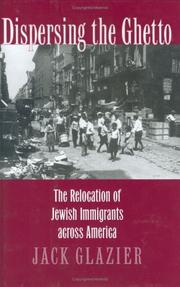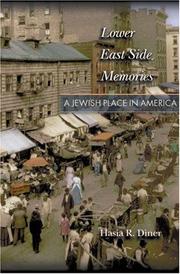| Listing 1 - 4 of 4 |
Sort by
|

ISBN: 0801435226 Year: 1998 Publisher: Ithaca, NY London Cornell University Press
Abstract | Keywords | Export | Availability | Bookmark
 Loading...
Loading...Choose an application
- Reference Manager
- EndNote
- RefWorks (Direct export to RefWorks)
Book
ISBN: 1501724630 Year: 2018 Publisher: Ithaca, NY : Cornell University Press,
Abstract | Keywords | Export | Availability | Bookmark
 Loading...
Loading...Choose an application
- Reference Manager
- EndNote
- RefWorks (Direct export to RefWorks)
American Jewish leaders, many of German extraction, created the Industrial Removal Office (IRO) in 1901 in order to disperse unemployed Jewish immigrants from New York City to smaller Jewish communities throughout the United States. The IRO was designed to help refugees from persecution in the Pale of Russia find jobs and community support and, secondarily, to reduce the Manhattan ghettoes and minimize antisemitism. In twenty-one years, the IRO distributed seventy-nine thousand East European Jews to over fifteen hundred cities and towns, including Chino, California; Des Moines, Iowa; and Pensacola, Florida. Wherever they went, these twice-displaced immigrants wrote letters to the IRO's main office. Robert A. Rockaway has selected, and translated from Yiddish, letters that describe the immigrants' new surroundings, work conditions, and living situations, as well as letters that give voice to typical tensions between the immigrants and their benefactors. Rockaway introduces the letters with an essay on conditions in the Pale and on early American Jewish attempts to assist emigrants.
Immigrants --- Jews, East European --- Correspondence. --- Industrial Removal Office (U.S.) --- United States. --- United States --- Emigration and immigration.
Book
ISBN: 1501724967 Year: 2018 Publisher: Ithaca, NY : Cornell University Press,
Abstract | Keywords | Export | Availability | Bookmark
 Loading...
Loading...Choose an application
- Reference Manager
- EndNote
- RefWorks (Direct export to RefWorks)
In the early twentieth century, the population of New York City's Lower East Side swelled with the arrival of vast numbers of eastern European Jewish immigrants. The teeming settlement, whose inhabitants faced poverty and frequent unemployment, provoked the attention of immigration restrictionists. Established American Jews-arrivals from the German states only a generation before-feared that their security might be threatened by the newcomers. They established the Industrial Removal Office (IRO) to assist in relocating the immigrants to the towns and cities of the nation's interior. Dispersing the Ghetto is the first book to describe in detail this important but little-known chapter in American immigration history.Founded in 1901, the IRO for nearly two decades directed the resettlement of Jewish immigrants in New York and other port cities to hundreds of communities nationwide, where the prospects of employment and rapid assimilation were brighter. Drawing on a variety of sources, including the IRO archive, local records, first-person accounts of resettlement, and the lively Jewish press, Jack Glazier recounts the operations of the IRO and the experiences of those it aided. He closely examines the complex relationship between the two sets of Jewish immigrants, emphasizing the mix of motives underlying the assistance the American Jews of German origin rendered the newcomers from eastern Europe.
Jews --- Jews, East European --- Urban Studies. --- Migrations. --- Charities. --- History. --- Industrial Removal Office (U.S.) --- United States --- Emigration and immigration.

ISBN: 0691007470 Year: 2002 Publisher: Oxford, England : Princeton University Press,
Abstract | Keywords | Export | Availability | Bookmark
 Loading...
Loading...Choose an application
- Reference Manager
- EndNote
- RefWorks (Direct export to RefWorks)
Manhattan's Lower East Side stands for Jewish experience in America. With the possible exception of African-Americans and Harlem, no ethnic group has been so thoroughly understood and imagined through a particular chunk of space. Despite the fact that most American Jews have never set foot there--and many come from families that did not immigrate through New York much less reside on Hester or Delancey Street--the Lower East Side is firm in their collective memory. Whether they have been there or not, people reminisce about the Lower East Side as the place where life pulsated, bread tasted better, relationships were richer, tradition thrived, and passions flared. This was not always so. During the years now fondly recalled (1880-1930), the neighborhood was only occasionally called the Lower East Side. Though largely populated by Jews from Eastern Europe, it was not ethnically or even religiously homogenous. The tenements, grinding poverty, sweatshops, and packs of roaming children were considered the stuff of social work, not nostalgia and romance. To learn when and why this dark warren of pushcart-lined streets became an icon, Hasia Diner follows a wide trail of high and popular culture. She examines children's stories, novels, movies, museum exhibits, television shows, summer-camp reenactments, walking tours, consumer catalogues, and photos hung on deli walls far from Manhattan. Diner finds that it was after World War II when the Lower East Side was enshrined as the place through which Jews passed from European oppression to the promised land of America. The space became sacred at a time when Jews were simultaneously absorbing the enormity of the Holocaust and finding acceptance and opportunity in an increasingly liberal United States. Particularly after 1960, the Lower East Side gave often secularized and suburban Jews a biblical, yet distinctly American story about who they were and how they got here. Displaying the author's own fondness for the Lower East Side of story books, combined with a commitment to historical truth, Lower East Side Memories is an insightful account of one of our most famous neighborhoods and its power to shape identity.
Immigrants --- Jews --- Social life and customs --- Intellectual life --- HISTORY / Jewish. --- Hebrews --- Israelites --- Jewish people --- Jewry --- Judaic people --- Judaists --- Ethnology --- Religious adherents --- Semites --- Judaism --- Emigrants --- Foreign-born population --- Foreign population --- Foreigners --- Migrants --- Persons --- Aliens --- Lower East Side (New York, N.Y.) --- New York (State) --- LES (New York, N.Y.) --- Nyu Yorḳ (State) --- NYS --- Niyū Yūrk (State) --- Nʹi︠u︡-Ĭork (State) --- Shtat Nʹi︠u︡ Ĭork --- State of New York --- State of N. York --- NY (State) --- N.Y. (State) --- N. York (State) --- نيويورك (State) --- ولاية نيويورك --- Wilāyat Niyū Yūrk --- Штат Нью-Ёрк --- Нью-Ёрк (State) --- Ню Йорк (State) --- Nova York (State) --- С̧ӗнӗ Йорк (State) --- Śĕnĕ Ĭork (State) --- Efrog Newydd (State) --- Kin Yótʼááh Deezʼá Hahoodzo --- Nííyóó Hahoodzo --- New Yorgi osariik --- Νέα Υόρκη (State) --- Nea Yorkē (State) --- Πολιτεία της Νέας Υόρκης --- Politeia tēs Neas Yorkēs --- Nueva York (State) --- Estado de Nueva York --- Nov-Jorkio --- Ŝtato de Nov-Jorkio --- État de New York --- Nua-Eabhrac (State) --- York Noa (State) --- Eabhraig Nuadh (State) --- Estado de Nova York --- Néu-Yok (State) --- Шин Йорк (State) --- Shin Ĭork (State) --- 뉴욕 주 --- Nyuyok-ju --- 뉴욕 (State) --- Nyuyok (State) --- Nuioka (State) --- Nú Yọk (State) --- Tchiaq York (State) --- New York Isifunda --- New York-fylki --- ניו יורק (State) --- מדינת ניו יורק --- Medinat Nyu Yorḳ --- Stat Evrek Nowydh --- Evrek Nowydh (State) --- Nou Yòk (State) --- Novum Eboracum (State) --- N̦ujorka (State) --- Niujorko valstija --- Niujorkas (State) --- Niorche (State) --- Њујорк (State) --- Njujork (State) --- Yancuīc York (State) --- ニューヨーク州 --- Nyū Yōku-shū --- ニューヨーク (State) --- Nyū Yōku (State) --- New York (Colony) --- Ethnic relations. --- Adler, Jacob. --- Aleichem, Sholem. --- American Vaudeville Theater. --- Baker, Zachary. --- Bible/Biblical. --- Café Metropole. --- Cahan, Abraham. --- Crossing Delancey. --- Current Literature. --- Diamond, Neil. --- Dissent. --- Eastern Europe. --- Eldridge Street Project. --- Ellis Island. --- Esther-Khaye. --- Forward. --- Franklin, Benjamin. --- Glackens, William. --- Goldreich, Gloria. --- Gropper, William. --- Hapgood, Hutchins. --- Humoresque. --- Industrial Removal Office. --- Jerusalem. --- Kelley, Florence. --- Levine, Lawrence. --- Lincoln, Abraham. --- Margolin, Elias. --- Mayflower. --- Raphaelson, Samuel. --- Rischin, Moses. --- Sanders, Ronald. --- Tenement Museum. --- The Jazz Singer. --- Uncle Moses. --- World War II/Holocaust. --- Yezierska, Anzia. --- Yiddish theater. --- Zagajewski, Adam. --- Zueblin, Charles. --- anti-Semitism. --- booksellers. --- business. --- food. --- garment industry. --- history. --- journalism. --- philanthropy. --- pogroms. --- settlement houses. --- summer camps. --- East Side, Lower (New York, N.Y.) --- Imigranci --- Żydzi --- obyczaje i zwyczaje --- życie intelektualne --- Nowy Jork (Stany Zjednoczone) --- stosunki międzyetniczne.
| Listing 1 - 4 of 4 |
Sort by
|

 Search
Search Feedback
Feedback About
About Help
Help News
News